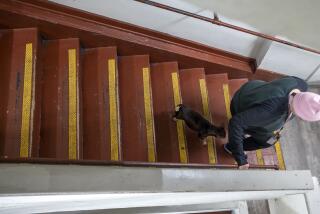Condo Group Settles for $8.6 Million : Court: Hidden Canyon Homeowners Assn. in Thousand Oaks charged Griffin Homes and subcontractors with shoddy construction.
Insurers for a developer and subcontractors that built a condominium project in the Hidden Canyon area of Thousand Oaks will pay $8.6 million to a homeowners’ association to settle a lawsuit charging them with shoddy construction.
The complicated 4-year-old suit against Calabasas-based Griffin Homes and dozens of subcontractors was finally settled last week after an exhaustive three weeks of court-ordered mediation sessions, the attorney for the association, Alexander Robertson IV, said Friday.
“I’m glad it’s over, I was looking forward to having it end,” said Linda E. Meyer, a professor at Pepperdine University School of Law who conducted the mediation. “It was emotionally draining for everyone involved.”
The Hidden Canyon Homeowners Assn. originally sought $50 million in damages against Griffin Homes, which filed for bankruptcy in 1992, Robertson said. A handful of subcontractors were ordered to pay $540,000 to the association last fall in partial settlement of the case.
Residents contended in the lawsuit that the 648-unit complex was poorly constructed and began to deteriorate soon after it was built. They complained about leaky roofs, cracked walls and uneven floors.
Because the bankruptcy protected the Griffin Homes’ assets from seizure, the association tried to recoup its losses through the developer’s insurance company, Robertson said. The insurance companies fiercely contested the suit.
“Their policies contained numerous exclusions for various types of damages,” Robertson said. “That’s the reason for the big difference,” between what the homeowners originally sought and what they received.
Bob Cohen, an attorney who represented the developer, could not be reached for comment Friday. But last year he said he hoped the matter would be settled out of court. He suggested that the subcontractors, and not Griffin Homes, should be held liable.
Robertson has maintained that memos by Griffin Homes to subcontractors show that the developer knew about the defects and urged subcontractors to ignore them. For example, according to Robertson, one subcontractor notified Griffin Homes that the builder had failed to waterproof Sheetrock used in construction, which would cause leaks after the walls were covered with stucco.
Robertson said the warning was ignored and the subcontractor was told to proceed with work.
In another instance, Griffin Homes hired a roofing expert from Texas to examine the roof after the developer had made several repairs, Robertson said. The consultant informed Griffin Homes in writing that the roof had serious problems that would continue for years.
Robertson said homeowners were never told about the consultant’s report.
The suit became complicated after Griffin Homes went bankrupt, said Meyer, who has a private mediation practice.
“That made the case more difficult to settle,” she said. “You had to first show there was a problem and that the problem was covered under” the various insurance policies.
She said the large number of defendants and insurance companies further complicated the case.
“There were 20 insurance companies at least, that represented the developer and the subcontractors,” she said. “The developer had four different insurance companies, all of whom were making claims that the coverage was not in their policy, or that it should be restricted to a particular year.
“Had this case not been settled, there would have to have been 300 depositions taken,” she added.
More to Read
Inside the business of entertainment
The Wide Shot brings you news, analysis and insights on everything from streaming wars to production — and what it all means for the future.
You may occasionally receive promotional content from the Los Angeles Times.










